From the Editors 21 October 2014
The Electronic Intifada was forced offline for more than six hours on Monday by a massive distributed denial of service (DDoS) attack.
This came days after IMEMC (International Middle East Media Center), another Palestine-focused online publication, was subjected to a similar attack.
A DDoS attack “is an attempt to make an online service unavailable by overwhelming it with traffic from multiple sources,” according to Digital Attack Map, a website sponsored by Google that tracks such attacks. “They target a wide variety of important resources, from banks to news websites, and present a major challenge to making sure people can publish and access important information.”
DDoS attacks do not require a breach of a target’s own security but rather assault it from the outside – though they do rely on breaches of security on other people’s computers.
“Attackers build networks of infected computers, known as ‘botnets,’ by spreading malicious software through emails, websites and social media,” says Digital Attack Map.
“Once infected, these machines can be controlled remotely, without their owners’ knowledge, and used like an army to launch an attack against any target.”
There are more than two thousand such attacks observed daily worldwide, says Digital Attack Map, which produces visualizations of DDoS attacks such as the one at the top of this post.
A form of censorship
DDoS attacks are widely seen as a threat to freedom of expression, prompting several initiatives to protect potential targets.
“The Internet is a powerful tool for spreading and expanding ideas. However, websites can be knocked offline easily through a distributed denial of service (DDoS) attack – censoring important voices,” says Project Galileo. “Public interest websites that cover political or artistic content are often the target of these attacks.”
Project Galileo is a collaboration between the web services company CloudFlare and more than twenty civil society and Internet freedom groups including the Electronic Frontier Foundation and the American Civil Liberties Union “to protect politically and artistically important organizations and journalists against attacks that would otherwise censor their work.”
Project Shield is an initiative with similar goals sponsored by Google.
Despite these efforts, DDoS attacks have proven difficult to prevent and those who launch them are difficult to identify. The Electronic Intifada, like many targets, was taking measures to protect against an attack, and is examining what it can learn from Monday’s incident.
Sometimes, however, Internet companies can be unsupportive. “The IMEMC was recently hit by a denial of service attack. Unfortunately, our previous provider refused to help secure the site, and we were forced to change provider,” editor Saed Bannoura told The Electronic Intifada. “Instead, they blamed the victim, and took our site offline.”While IMEMC was down, it continued publishing news on its Facebook page.
Massive surge in interest
The DDoS attacks come in the wake of Israel’s summertime massacre in Gaza which saw a surge of interest in Palestine-related news.
Bannoura said IMEMC saw a jump in traffic from “two million hits per month to ten million hits per month” during the Gaza attack.
The Electronic Intifada also saw a massive increase in its readership, with more than 15 million pageviews during the 51 days of the attack on Gaza – a two thousand percent increase over the same period in 2013.
The good news is that independent news organizations are taking an ever more prominent and effective role in circumventing mainstream corporate and public media’s self-censorship on Palestine. The bad news is that this may make them more prominent targets for those who want to silence them.
“As a news website that provides daily updates from occupied Palestine, we face constant threats and harassment, but we will not be intimidated, and will continue to provide factual accurate reports from Palestine,” IMEMC’s Bannoura said.
The Electronic Intifada will, of course, be doing the same.




